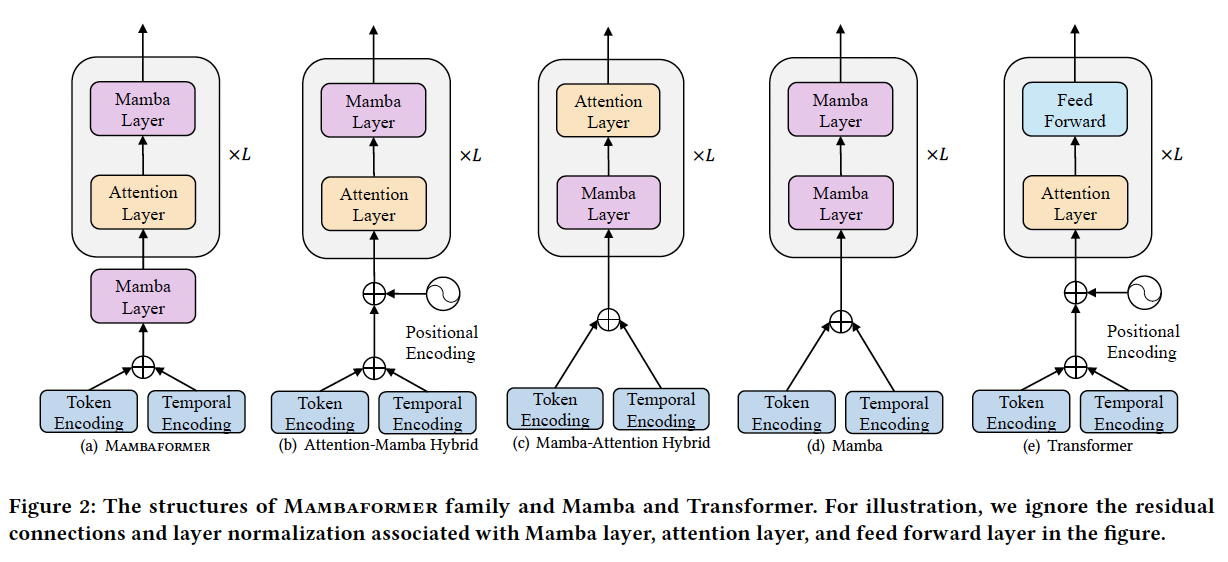Integrating Maamba and Transformer for Long-Short Range TSF
Contents
- Abstract
- Preliminaries
- Methodology
- Overview
- Embedding Layer
- Mamba Pre-processing Layer
- MambaFormer Layer
- Forecasting Layer
- Experiments
0. Abstract
MambaFormer
- Mamba (for LONG range dependency)
- Transformer (for SHORT range dependency)
1. Preliminaries
(1) Problem Statement
- \(\mathcal{L}=\left(\mathrm{x}_1, \mathrm{x}_2, \ldots, \mathrm{x}_L\right)\) with length \(L\),
- where each \(\mathbf{x}_t \in \mathbb{R}^M\) at time step \(t\) is with \(M\) variates
- \(\mathcal{F}=\left(\mathbf{x}_{L+1}, \mathbf{x}_{L+2}, \ldots, \mathbf{x}_{L+F}\right)\) with length \(F\). B
- \(\left(c_1, c_2, \ldots, c_L\right)\) : Temporal context information with dimension \(C\)
- assumed to be known ( e.g. day-of-the-week and hour-of-the-day )
(2) SSM
a) Continuous version
\(\begin{aligned} h_t & =\overline{\mathrm{A}} h_{t-1}+\overline{\mathrm{B}} x_t \\ y & =\mathrm{C} h_t \end{aligned}\).
- where \(\mathrm{A} \in \mathbb{R}^{N \times N}, \mathrm{~B} \in \mathbb{R}^{N \times 1}\), and \(\mathrm{C} \in \mathbb{R}^{1 \times N}\) are learnable matrices.
- discretized from continuous signal into discrete sequences by a step size \(\Delta\).
b) Discrete version
- Discrete parameters \((\overline{\mathrm{A}}, \overline{\mathrm{B}})\)
- can be obtained from continuous parameters \((\Delta, \mathrm{A}, \mathrm{B})\)
- via zero-order hold \((\mathrm{ZOH})\) rule
- \(\overline{\mathrm{A}}=\exp (\Delta \mathrm{A}), \overline{\mathrm{B}}=\exp (\Delta \mathrm{A})^{-1}(\exp (\Delta \mathrm{A})-\) I) \(\Delta\) B.
c) Inference
\(\begin{aligned} \overline{\mathbf{K}} & =\left(\mathbf{C} \overline{\mathbf{B}}, \mathbf{C} \overline{\mathbf{A B}}, \ldots, \mathbf{C} \overline{\mathbf{A}}^k \overline{\mathbf{B}}, \ldots\right) \\ y & =x * \overline{\mathbf{K}} \end{aligned}\).
- where \(\overline{\mathbf{K}}\) is a convolutional kernel.
2. Methodology
(1) Overview of MambaFormer
Hybrid architecture
- Mamba + Transformer
- adopts Decoder-only style
(2) Embedding Layer
a) Token Embedding
Raw TS \(\rightarrow\) Embed via 1d CNN
- capture locla information
b) Temporal Embedding
Numerical value + Temporal context information
Notation
- Input sequence: \(\mathrm{X} \in \mathbb{R}^{B \times L \times M}\)
- Associated temporal context: \(C \in \mathbb{R}^{B \times L \times C}\)
Embedding layer
- \(\mathrm{E}=E_{\text {token }}(\mathrm{X})+E_{\text {tem }}(\mathbf{C})\).
- where \(\mathrm{E} \in \mathbb{R}^{B \times L \times D}\) is output embedding
- \(E_{\text {token }}\) and \(E_{\text {tem }}\) : token embedding layer & temporal embedding layer
- No need for positional embedding
(3) Mamba Pre-processing Layer
Mamba pre-processing block
- \(\mathrm{H}_1=\operatorname{Mamba}(\mathbf{E})\).
- where \(\mathrm{H}_1 \in \mathbb{R}^{B \times L \times D}\) is a mixing vector
- including token embedding, temporal embedding, and positional information.
(4) MambaFormer Layer
a) Attention Layer
For SHORT-range time series dependencies in the transformer
\(\rightarrow\) Use masked multi-head attention layer to obtain correlations between tokens
- Masking mechanism: to prevent positions from attending to subsequent positions
(Head \(i=1,2, \ldots, h\))
Transforms the embedding \(\mathrm{H}_1\) into…
-
(Q) queries \(\mathbf{Q}_i=\mathrm{H}_1 \mathbf{W}_i^Q\),
- (K) keys \(\mathbf{K}_i=\mathbf{H}_1 \mathbf{W}_i^K\),
- (V) values \(\mathbf{V}_i=\mathbf{H}_1 \mathbf{W}_i^V\),
where \(\mathbf{W}_i^Q \in \mathbb{R}^{D \times d_k}\), \(\mathbf{W}_i^K \in \mathbb{R}^{D \times d_k} \in\), and \(\mathbf{W}_i^V \in \mathbb{R}^{D \times d_v}\) are learnable matrices.
Output: \(\mathrm{O}_i=\operatorname{Attention}\left(\mathrm{Q}_i, \mathrm{~K}_i, \mathrm{~V}_i\right)=\operatorname{softmax}\left(\frac{\mathrm{Q}_i \mathrm{~K}_i^T}{\sqrt{d_k}}\right) \mathrm{V}_{\mathrm{i}}\).
- outputs \(\mathrm{O}_i\) of each head are concatenated into a output vector \(\mathbf{O}\)
- with the embedding dimension \(h d_v\).
Projection
- Projection matrix \(\mathbf{W}^O \in \mathbb{R}^{h d_v \times D}\)
- Output of attention layer \(\mathbf{H}_2=\mathrm{OW}^O \in \mathbb{R}^{B \times L \times D}\).
b) Mamba Layer
Incorporate the Mamba layer
- to overcome computatiaonal challenges of the Transformer
**Mamba block **
- Sequence-sequence module
- with the same dimension of input and output
- Procedure
- (1) Takes an input \(\mathrm{H}_2\)
- (2) Expand the dimension by two input linear projection
- Projection 1)
- Processes the expanded embedding through a convolution and SiLU activation before feeding into the SSM.
- Goal: Select input-dependent knowledge and filter out irrelevant information.
- Projection 2)
- Followed by SiLU activation ( as a residual connection )
- As a multiplicative gate
- Projection 1)
- (3) Output \(\mathrm{H}_3 \in \mathbb{R}^{B \times L \times D}\)
(5) Forecasting Layer
\(\widehat{\mathrm{X}}=\text { Linear }\left(\mathrm{H}_3\right)\).
- where \(\widehat{\mathbf{X}} \in \mathbb{R}^{B \times L \times M}\)
3. Experiments

